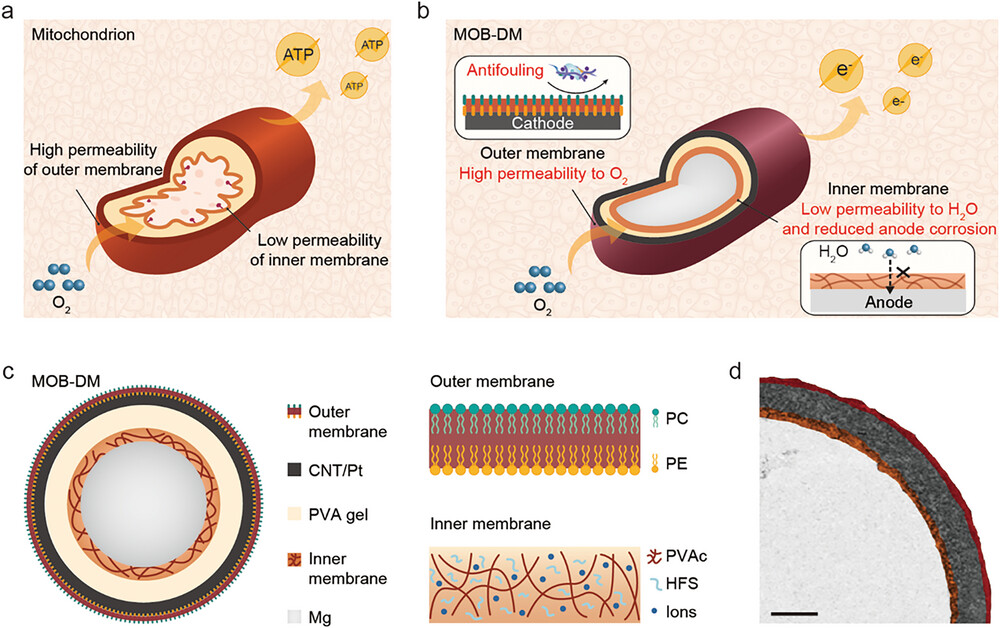| Oct 29, 2023 |
| |
|
(Nanowerk Spotlight) Implantable medical devices like pacemakers and biosensors have revolutionized treatments for many debilitating conditions, improving quality of life for millions. However, the inadequate batteries powering these devices remain a major limitation, restricting further progress.
|
|
Today’s pacemakers, biosensors and other in-body electronics overwhelmingly rely on conventional lithium or similar batteries. But these batteries have low energy density, meaning they either require frequent charging or replacement via invasive surgery, or the implants must be made bulky to accommodate larger batteries. Neither of these is ideal – repeated operations raise risks and complications for patients, while large devices can cause discomfort and limit implantation sites. Additionally, toxic electrolytes and electrodes raise concerns of harmful leaching into the body over time.
|
|
These deficiencies of batteries powering medical implants are hindering development of smaller, smarter, and more capable devices.
|
Reporting their findings in Advanced Materials (“A Mitochondrion-Inspired Magnesium–Oxygen Biobattery
with High Energy Density In Vivo”), scientists have developed a novel biobattery inspired by the energy-generating mitochondria inside cells that could provide the boost medical implants need.
|
 |
| Schematic illustration and structural characterization of the mitochondrion-inspired MOB-DM. a) Schematic of the structure and function of the mitochondrion, which efficiently utilizes O2 to generate chemical energy through its unique double-membrane structure and permeability. b) The MOB-DM, inspired by the mitochondrion, produces stable electrical energy for powering electronic systems in vivo. The inner membrane of the MOB-DM is less permeable to H2O and thus inhibits the corrosion of the Mg anode, while the outer membrane is highly permeable to O2 and compatible with the biological environment. c) Schematic illustrating the structure of the MOB-DM and the composition of the inner and outer membranes. d) Cross-sectional SEM image of the MOB-DM, which shows the Mg anode, inner membrane (marked in orange), PVA gel electrolyte, and outer membrane modified CNT/Pt cathode (marked in red) from the inside out. Scale bar: 30 µm. (Reprinted with permission by Wiley-VCH Verlag)
|
|
Searching for a high-energy, biocompatible alternative, researchers at Nanjing University turned to the powerhouses inside our cells. Mitochondria efficiently harness oxygen thanks to a double membrane structure. The porous outer membrane allows oxygen in, while the less permeable inner membrane protects the energy-producing interior.
|
|
The team designed a biobattery with a similar double membrane enveloping the key components. The anode consists of biocompatible magnesium. A hydrogel electrolyte sits between this and a cathode made from platinum-coated carbon nanotubes to catalyze oxygen reactions.
|
|
A novel hydrophobic polymer-silica inner membrane coating protects the magnesium anode from corrosion by water. Tests showed it decreased the anode’s corrosion rate around tenfold. The water-repelling barrier ensures stable performance regardless of the battery’s size or surrounding moisture.
|
|
The biobattery’s outer membrane is made from a modified phospholipid layer. Inspired by cell membranes, this resists biofouling while allowing oxygen to pass through. Experiments confirmed the coating prevented common blood proteins from sticking compared to uncoated materials. This boosts long-term performance in biological fluids.
|
|
Implanted in mice, the mitochondria-inspired biobattery achieved a remarkable energy density of 2517 watt-hours per liter based on total device volume. This is around 2.5 times higher than commercial lithium batteries for medical devices. The biobattery also stably powers implants in different tissue environments like muscle or brain.
|
|
Analyses found the battery’s discharge process does not significantly impact oxygen levels or other biological markers in the body. Tests also showed excellent biocompatibility, with no excessive immune reactions from surrounding tissue. This confirms the outer membrane’s suitability for biointegration.
|
|
To demonstrate real-world application, the researchers integrated their biobattery into miniaturized brain stimulation and stomach monitoring devices successfully implanted in mice. The high energy density in a biocompatible form factor enables such self-contained implants not previously feasible.
|
|
The novel biomimetic design delivers on both key needs for medical electronics – high energy storage and biological compatibility. This research provides a template for developing a new generation of biobatteries tailored for powering advanced in-body devices. The mitochondria-inspired approach paves the way for implants with expanded capabilities that could transform medical treatments.
|

By
Michael
Berger
– Michael is author of three books by the Royal Society of Chemistry:
Nano-Society: Pushing the Boundaries of Technology,
Nanotechnology: The Future is Tiny, and
Nanoengineering: The Skills and Tools Making Technology Invisible
Copyright ©
Nanowerk LLC
|
|
|
- SEO Powered Content & PR Distribution. Get Amplified Today.
- PlatoData.Network Vertical Generative Ai. Empower Yourself. Access Here.
- PlatoAiStream. Web3 Intelligence. Knowledge Amplified. Access Here.
- PlatoESG. Carbon, CleanTech, Energy, Environment, Solar, Waste Management. Access Here.
- PlatoHealth. Biotech and Clinical Trials Intelligence. Access Here.
- Source: https://www.nanowerk.com/spotlight/spotid=63958.php





